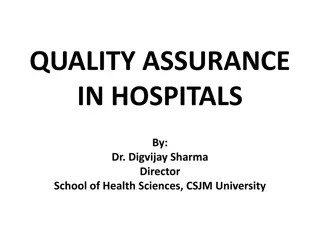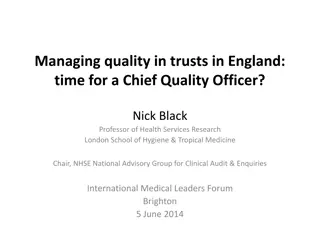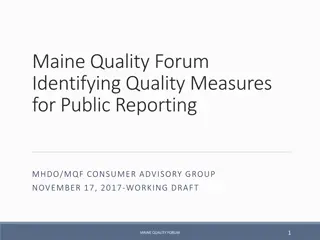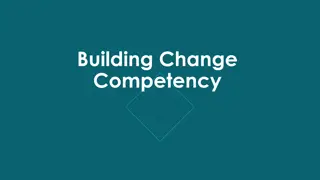Understanding Quality Care and Change Management in Healthcare
Quality care in healthcare involves providing safe, effective, patient-centered, timely, efficient, and equitable services to improve health outcomes. Change management is essential for continuous improvement but may face resistance due to factors like loss of control, identity, and competence. Process, culture, and readiness play key roles in successful change implementation.
Download Presentation

Please find below an Image/Link to download the presentation.
The content on the website is provided AS IS for your information and personal use only. It may not be sold, licensed, or shared on other websites without obtaining consent from the author. Download presentation by click this link. If you encounter any issues during the download, it is possible that the publisher has removed the file from their server.
E N D
Presentation Transcript
Using QAPI to Improve Care: Putting it to Work in the Real World Forum of ESRD Networks Medical Advisory Council http://esrd.aclark.net/logo.jpg
What is quality care and why should I care? Institute Of Medicine The degree to which health services for individuals and populations increase the likelihood of desired health outcomes and are consistent with current professional knowledge. Safe, Effective, Patient-centered, Timely, Efficient, and Equitable
What is quality care and why should I care? CMS Definition of Quality Is The Right Care for Every Patient Every Time
Improving Through Change REMEMBER: All improvement requires change BUT Not all change IS improvement!
What is Change? Change is a departure from an existing process or way of doing something, to a new process or a different way of doing the same thing Ezekiel Oseni, CISA, ACA, ACIP, ACS Change Management in Process Change Volume 1, 2007
Why Do We Resist Change? Loss of control - I don t have enough information Loss of identity - We ve always done it this way Loss of competence - I m afraid I ll make a mistake...
Process Change People Policy Procedure Equipment
Culture Change Corporate culture The total sum of the values, customs, traditions and meanings that make a company unique. Corporate culture is often called "the character of an organization" The values of a corporate culture influence the ethical standards within a corporation, as well as managerial behavior.
Process readiness + Culture readiness = Change in Outcomes
What is Change Readiness? Category 10% Ready 50% Ready 90% Ready Leadership clear, commitment clear in some areas Clear management commitment Leading Change No one in charge Most happy with status quo Many think a change is needed Everyone knows a change is needed Shared Need Some consensus on what is needed, but also some apathy Everyone knows the necessary outcome Vision What vision? Some resources dedicated, more are needed A staffer might help someone All needed resources are available Mobilizing commitment Some things are measured, but staff at times gut feeling Everyone has their own opinion Clear measures and goals Monitoring Progress Everyone knows what has to be done to embed change Why does anything have to be done Discussion has begun, but hasn t finished Anchoring Change Palmer 2004: Making Change Work: Practical Tools for Overcoming Human Resistance to Change
Creating Change Evaluate processes People, Policy, Procedure, Equipment Determine barriers to change Identify ways to overcome barriers Seek out best practices Create environment of collaboration
From the top down Support Resources CREATIVE CHANGE From the ground up Problem identification Idea development
Using the Team to Drive Improvement Multidisciplinary Common Goal Day-to-Day Knowledge Physician Buy-in
The Composition of an Effective Team System Leadership Technical Expertise Day-to-day Leadership
The Interdisciplinary Team Medical Director Nurse Manager Dietitian Social worker Biomed Tech Others Other nephrologists(?) Surgeon Staff members including PCTs
Changes Need to be Evidenced Based Patient Centered System Based
Why Should I Care About Quality Improvement? Improved patient outcomes Improved patient safety Increased customer satisfaction Improved staff morale Reduction of rework Cost savings
And so Our approach to quality improvement in healthcare needs to be focused on identifying areas for change, creating change, and measuring change.
IHI Model for Improvement What are we trying to accomplish? How will we know that a change is an improvement? What changes can we make that will result in an improvement?
Developing a Goal Statement Where are we currently why is this a problem? What does our data show? What is our trend? Where do we want to be? What knowledge do we have? What is our goal?
QAPI: Using Knowledge to Improve Improvement comes from the application of knowledge Any approach to improvement must be based on building and applying knowledge Significant, long-term, positive impact only occur when someone takes the initiative
Setting Goals Be realistic Be specific Understanding CMS or Network-set goals vs. facility or corporate-set goals Set both short term and long term In order to reach our long term goal, what do we need to accomplish monthly, quarterly, etc. Remember how to eat an elephant
What Are We Trying to Accomplish? Goal/Aim Statement Our rate for catheters >90 days is 35% KDOQI states that the 90 day catheter rate should be < 10% We will have a 25% catheter rate in 6 months
How will we know a change is an improvement? Collect and trend data Identify sources of data Review and trend data monthly Analyze by various characteristics Draw conclusions with the team
Data Sources Data is NOT a four letter word! Data is: Your observations what you hear and what you see Your measurements what you keep track of How you report your observations and measurements What is the benchmark? What data sources do you have?
Your Observations Subjective Data Is there an opportunity for improvement? Too many catheters? Too many access infections? Patient safety issues? Is there something that everyone is complaining about? Is there a process that is too cumbersome? Medication errors?
Your Measurement Objective Data Begin to collect information about your problem, your observation Collect simple points of information at regular intervals over time KISS counting the number of days between episodes of infections might be simpler and more meaningful that collecting every episode of access infection What is the trend?
How Will We Know a Change is an Improvement? We will collect baseline 90 day catheter rates at the beginning of the project We will collect 90 day catheter data each month and trend We will collect 90 days catheter data at the end of 6 months to evaluate the success of the project: Our catheter rate will be 25% or less
What changes will result in an improvement: finding root causes Don t stop with surface issues go deeper Brainstorming to discover all root causes All disciplines all team members Use a root cause tool Fishbone diagram 5 Whys Other tools
Root Cause Analysis Medical Surgical Technical Desired Goal Baseline Staff-Related Education Patient
Facility: ______________________ Number of Patients: _________ Month/Year: __________________ For each patient with a CVC to be completed monthly. Put a check mark in each box that applies for the patient. Vascular access surgeon Patient has no vessels for increased cardiac output E placement of fistula/graft A induced by a fistula/graft due to cardiac condition new fistula/graft planned Established patient with access sites exhausted G documented by vessel Awaiting a living donor All possible graft/fistula AV fistula by mapping New patient awaiting New patient awaiting precludes fistula/graft maturation/healing of B failed fistula/graft with C Appointment made Catheter infections Severe peripheral MD referral barrier Unable to tolerate vascular disease F Patient refuses Patient initials fistula or graft placement transplant H mapping barrier D Comments: Comments: Comments: Comments: Comments: Comments: Comments: Comments: Comments: Comments: TOTAL (Count checked boxes)
5 Whys Why did this occur? But why did that occur? So why did that occur? And then why did that occur? OK, so then why did that occur?
What are the barriers? What are the barriers to overcoming these root causes? What barriers are within your control and what are not?
What are our root causes? Problem: 35% of patients have catheters for more than 90 days Goal: Decrease 90 day catheter rate to 25% in 6 months Root cause(s): Difficulty in getting new accesses placed
Developing your QAPI Plan Identify strategies All team members need to have a role Someone needs to be accountable and in charge Tasks need to be assigned and dates set to re- evaluate Plan needs to be dynamic needs to be reviewed at least monthly
Developing your QAPI Plan ACT What changes are to be made? What will be the next cycle? PLAN State the objective Develop a plan to carry out the cycle Act Plan Study Do STUDY Complete analysis Summarize what was learned DO Carry out the plan Document observations Analyze the data
FACILITY NAME: PROVIDER NUMBER: DATE COMPLETED: TEAM MEMBERS CONTACT: Facility 1. PROBLEM STATEMENT: 2. 3. GOAL: 4. ROOT CAUSE(S): 1. 2. 3. BARRIER(S): 5. 6. 7. 8. External 1. 2. 3. 1. 2. 3. ESTIMATED COMPLETION DATE ACTUAL COMPLETION DATE RESPONSIBLE TEAM MEMBER START DATE COMMENTS TASKS (STATUS, OUTCOMES, EVALUATION, ETC.) 1. 2.
Percent of Patients Dialyzing with a catheter for > 90 days 80% 70% 60% Project Implemented 50% 40% 30% 20% 10% 0% Jan Feb Mar Apr May June
Evaluate and Re-evaluate Review plan regularly Use data to determine Are we improving? Are we seeing unintended consequences? Does the plan need revision? Should we bring others to the team? If so, who is the best person to help?
What do you do at the end?? Evaluate! Did we achieve our overall goal? If not, why not? If so, make it a permanent change If not, what new strategies can we develop to try? Are there best practices we can adopt? Are there additional resources we need? Are there new partners we can bring to the team?
ESRD Network Resources www.esrdnetworks.org
ANNA Resources www.annanurse.org
Institute for Healthcare Improvement www.ihi.org
In Conclusion Every system is perfectly designed to achieve the results that it gets. Paul Batalden
The definition of insanity is doing the same thing over and over again and expecting different results Albert Einstein
Why Do QAPI? Because CMS says so? Because the Network is on my tail? Because we won t get paid if our outcomes are bad? Because it s the right thing to do the right care for every patient every time!
Thank You! Questions?























